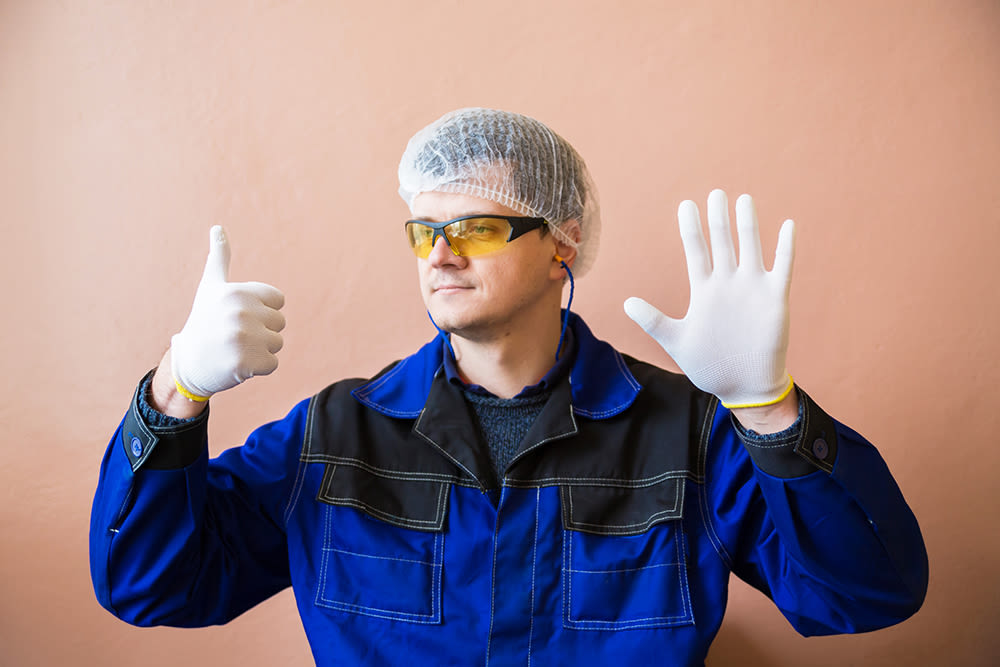
Food safety is all about reducing the risk of food contamination as much as possible and aiming to deliver delicious, safe meals to customers. An employee’s work uniform can carry contaminants and also develop unsightly stains. It’s important to set clothing requirements for anyone who handles food to reduce the risk a person presents when it comes to safety.
Food Safety Clothing Requirements
The following is a list of clothing requirement advice that can help to keep a kitchen safe:
Hair Restraints
It’s deceptively easy for hair to get into food. Even if hair itself doesn’t, oils and dead skin from around the hair and scalp can also potentially contaminate food. This is why it is good practice for anyone involved in food preparation to wear hair restraints.
These tend to become more important with longer hair. Generally, a good rule is to at least have anyone with shoulder length hair be in some kind of hair restraint, like a hair net. In some cases, this may even be legally mandated in your area of operation.
Shirts
Various types of shirts are appropriate in the kitchen, although many kitchens opt for a uniform to ensure employees are wearing clean, well-maintained clothes on the part of their body that often gets the closest to food being prepared and served. Generally, shirts should be of a single color, with white a very popular choice, so they cannot hide stains or other signs of contamination.
The torso is often one of the areas that is most likely to encounter mess in a kitchen and similar areas. Aprons can be an excellent way to protect clothes from staining and potentially contaminating spills, although one must also take special care to keep aprons clean, as they often aren’t washed or changed frequently enough.
Pants
Pants are less likely to come into contact with food compared to a shirt, but wearing appropriate pants is still an important part of keeping a kitchen hygienic. As with shirts, there is a wide array of pants that would be considered appropriate for the kitchen, and similar wear like skirts can also work in place of pants. It’s important that pants are clean, don’t hide stains and contaminants, and don’t have any holes or tears that may expose the skin underneath.
This isn’t just a cleanliness issue. It’s also about safety for the wearer. Kitchens can sometimes have very hot liquids splashing about. While most people imagine these things as a risk to the hands and arms (which they absolutely can be), liquids like hot oil can burn anywhere that’s exposed.
Shoes
The ideal footwear for a kitchen are sturdy, low-heeled shoes. They need to fit properly, without the foot shifting around inside the shoe. Shoes used in a kitchen should be grippy, helping to prevent slips even if a person steps on a wet surface.
One of the most important features of shoes intended for the kitchen is that they’re closed. Open shoes like sandals are a major hazard in the kitchen.
Jewelry
Jewelry can be deceptively dirty and shouldn’t be encouraged in the kitchen. Items like rings and bangles can hide food particles and other contaminants on their surfaces, which can then get into the food a person is handling. While it might be reasonable to allow certain types of jewelry, like wedding bands, and similar items, like medical bracelets, these items still present some level of risk that employees need to be made aware of, so they can take extra effort to keep them clean.
Clean Often
Kitchens, pantries, and anywhere else food regularly passes through need to be cleaned frequently. Additionally, a business needs to consider the body parts that frequently come near food, as the clothes on those employees (and their bodies) also need to stay clean to help keep customers safe and the food one provides at its best.
It’s better to clean too often rather than not enough. It is often easiest to clean messes soon after they occur. A spill can get harder to clean as it dries and sets.
Stay Vigilant & Cautious
When considering employee clothes and any other food safety issues, stay vigilant and cautious. Try to understand some of the biggest sources of contamination and stains in the kitchen, especially things like raw meat and their juices.
If it’s ever unclear whether a piece of clothing or surface may or may not be contaminated or otherwise dirty, assume that it is and have someone address the issue immediately. Remember that even a single incident of food poisoning or other illness after a meal may cause a customer never to return or even talk negatively about your business online. If the cause is negligence, it can become an ethical, legal, and financial headache. A handful of such incidents can have a serious impact on a business over its lifetime.
Alsco Uniforms & Food Safety Clothing Requirements
Good food hygiene practices aren’t especially difficult to adopt, but they need to be taken seriously. Hygiene issues in the kitchen can do serious harm to a company’s reputation. In the worst cases, it may cause a business to fail inspection or otherwise experience legal problems.
Make employees aware of what’s expected of them in terms of food processing uniforms. Regularly address any issues with employees that aren’t in line with your company policy.
At Alsco Uniforms, we can simplify the process of maintaining a good dress policy in the kitchen for both staff and management. Check out our uniform rental services to learn how you can rent clean, sharp-looking uniforms at a competitive rate, which is an easier process than managing your uniform and gear inventory yourself. Our uniform cleaning service ensures clean uniforms for every shift. We can help you assess your food safety clothing needs and how best to fulfill them. Call us today to learn more.
References
Food Service Employee Hygiene Practices (Dress Code). (April 2021). Head Start of Lane County.
